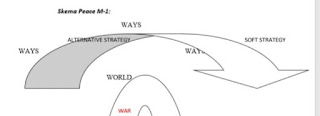CULTURE OF PEACE
I. S. Agustiani Agoestian
A peace culture is a culture that promotes peaceable diversity. Such a culture includes lifeways, patterns of belief, values, behavior, and accompanying institutional arrangements that promote mutual caring and well-being as well as an equality that includes appreciation of difference, stewardship, and equitable sharing of the earth’s resources among its members and with all living beings. It offers mutual security for humankind in all its diversity through a profound sense of species identity as well as kinship with the living earth. There is no need for violence. In other words, peaceableness is an action concept, involving a constant shaping and reshaping of understandings, situations, and behaviors in a constantly changing lifeworld, to sustain well-being for all.This is a far cry from stereotyped notions of peace as a dull, unchanging end state. A static image of peace, as reflecting human inactivity, is dramatically opposed to the characterization of peace as process, of peacebuilding as adventure, exploration, and willingness to venture into the unknown. Pacifism, which literally refers to the making of peace (from pace and facere) is often mistakenly understood as passivism. One major attitudinal obstacle to the acceptance of peaceableness as a desirable social norm is the connotation of inactivity associated with it.
Society does not exist apart from the activities and environments that sustain, shape, and reshape it. The ceaseless culture-creating activity that characterizes the social body involves interaction at every level, from the intrapersonal (the inner life of the individual human being) to the interpersonal – in household, neighborhood, and community, on through successive levels of civic organization from city to the United Nations, and finally to interaction with the planetary lifeworlds of which we are a part. Because there is constant interpenetration of levels, the societal capacity for aggression or peacebuilding depends on patterns developed in every domain, from the individual and the interpersonal to the national, and interenvironmental, for dealing with the ever-present conflicts that arise from the great diversity of human and more-than-human wants and needs.
It is how we deal with difference that determines how peaceable society is. Nature never repeats herself. Therefore, no two human beings are alike. Difference is a basic fact of life. Among the needs every person is born with are two of special importance to our capacity for peaceableness. One is the need for bonding, for closeness to and acceptance by other human beings. The other basic need is the need for space, separateness from others, room to be one’s own self, to be autonomous. A society with only bonding relationships would be a passive, dull, enclosed society.
A society in which separateness
predominated would be an aggressive society in which everyone would be
concerned with their own space. When groups of humans hold the need for bonding
and autonomy in balance – nurturing one another, engaging in many cooperative
activities, but also giving each other space – then we find the conditions for
peace culture. Another very important dimension of that peace culture is
bonding with, feeling at home in, the living bioregion that the members of that
culture inhabit. Groups characterized by power struggles, patterns of
domination of the strong over the weak, of men over women, by frequent physical
violence and constant competition, and seeing nature as something to be
conquered can be thought of as warrior cultures. We will not find peace
cultures or warrior cultures in a ‘pure’ form. Peaceable societies will have
some conflictual behavior, and war-prone societies have some patterns of
nurturant behavior in certain settings and under certain conditions.
In general, societies tend to be a blend of peaceable and warrior culture themes – the balance between the themes varying from society to society and from historical moment to historical moment. In our time, the tensions between the two themes have become a heavy social burden as a worldwide military forcing system linked to a destructive, planet-harming mode of industrialization and urbanization is distorting the human capability for creative and peaceful change. Indeed we can’t ovoid the violence in society but through understanding the peace culture and culture of peace, hope the peace can be applied in daily life.
It is there, but not well reported. The
tendency of planners and policymakers to prepare for worst-case scenarios
leaves societies unprepared for the opportunities involved in best-case
scenarios. Nevertheless, the longing for peace has not gone away. The
hiddenness, and the longing, create an urgency to understand what works to
strengthen one of the two cultures and what works to weaken the other. We are
not helpless. We have at our fingertips an incredible storehouse of wisdom and
knowledge from the past and new knowledge, new wisdom, new science and
technology from our discovery-minded present that, together, offer great
resources for the rebuilding of peaceful lifeways for the planet as a whole. A
richer and more diversified peace culture than any of us can now easily
imagine, an interconnected global peace culture, is there to be built out of
the languages and lifeways and knowledge and experience worlds of the ’10,000
societies’ now spread across the 185 states of today’s world. The possibilities
for the transformation of our current war- and violence-prone international
system into an interconnected localist world of adventurous but peaceful problem
solvers, using technology to nurture the planet rather than to stress it, exist
all around us.



Comments
Post a Comment